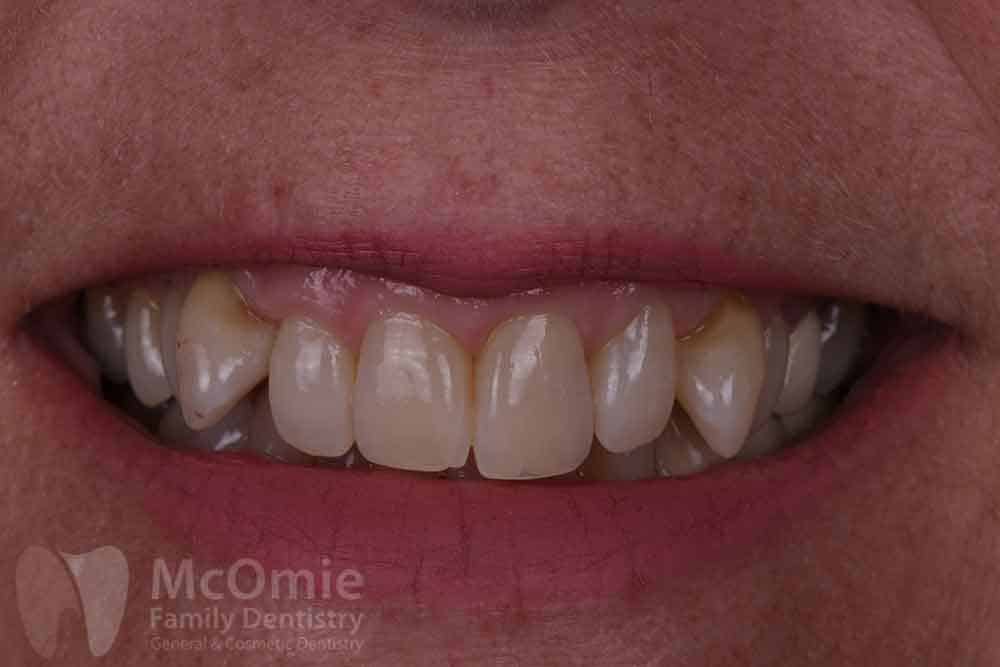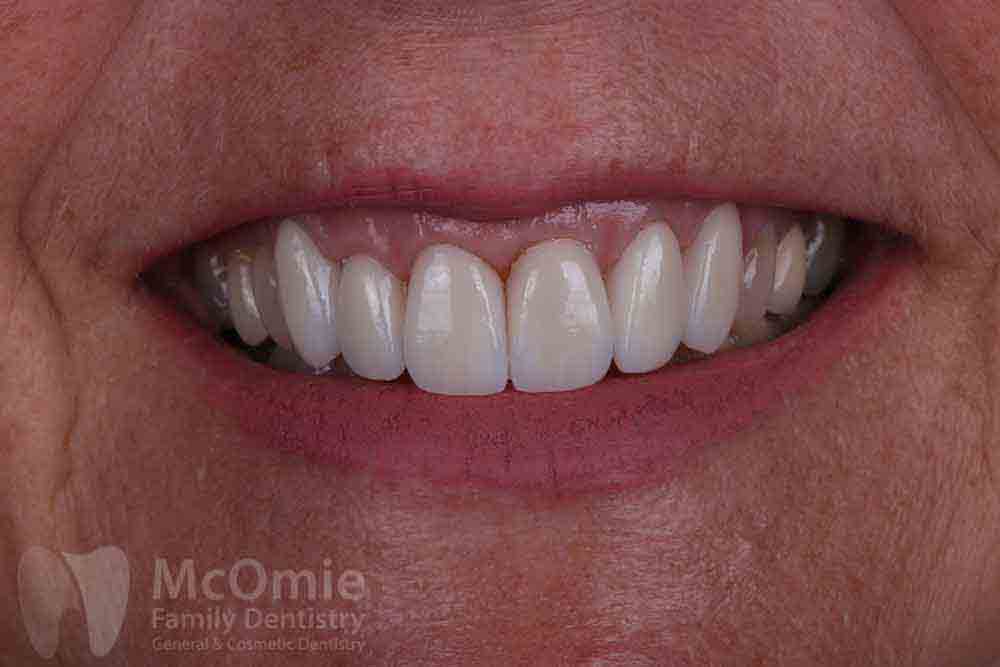When considering dental restorations to enhance both the appearance and functionality of your teeth, porcelain veneers and dental crowns are two popular choices. Understanding their differences is crucial in selecting the best option for restoring teeth.
Understanding Dental Veneers
Dental veneers are thin, custom-made shells crafted from materials such as porcelain or composite resin, designed to cover the front surface of teeth. They are primarily utilized for cosmetic enhancements, addressing issues like:
- Discoloration – Stubborn stains unresponsive to traditional whitening methods.
- Chipped or Worn Teeth – Minor fractures or wear affecting the tooth’s appearance.
- Misalignment or Gaps – Slightly crooked teeth or small spaces between them.
- Irregularly Shaped Teeth – Teeth with uneven shapes or sizes.
The veneer process involves minimal enamel removal, preserving most of the natural tooth structure. They provide a natural appearance, stain resistance, and long-lasting results, making them a top choice for a smile makeover.
💡Curious about whether veneers are right for you? Learn more about what dental veneers are and whether they’re worth it before making your decision.
Understanding Dental Crowns
Dental crowns, commonly referred to as caps, are dental restorations that envelop the entire visible portion of a tooth. They are typically employed when a tooth is significantly damaged or decayed, providing structural support and restoring functionality. Indications for crowns include:
- Extensive Decay – Cavities too large for fillings.
- Fractured or Broken Teeth – Teeth with substantial cracks or breaks.
- Post-Root Canal Therapy – Protection and reinforcement of a tooth following root canal treatment.
- Severely Worn Teeth – Teeth that have been extensively worn down, possibly due to grinding (bruxism).
The procedure for placing a crown necessitates removing a considerable portion of the tooth structure to ensure a proper fit. Crowns can be fabricated from various materials, including porcelain, metal, or a combination of both, and are designed to mimic the appearance of natural teeth while offering strength and durability.
💡 Want to know more about how crowns work? Read our essential guide to dental crowns to learn about their benefits, process, and how they can restore your smile.
Porcelain Veneers vs. Dental Crowns: Key Differences
1. Coverage
- Veneers – Cover only the front surface of the tooth.
- Crowns – Encapsulate the entire tooth.
2. Purpose
- Veneers – Primarily cosmetic, enhancing the tooth’s appearance.
- Crowns – Restorative, providing strength and functionality to compromised teeth.
3. Tooth Preparation
- Veneers – Require minimal enamel removal.
- Crowns – Involve significant reduction of the tooth structure.
4. Durability
- Veneers – Durable but less robust than crowns; suitable for teeth with minor issues.
- Crowns – More robust, ideal for teeth requiring substantial support.
When to Choose Veneers
Veneers are an excellent option when the objective is to improve the aesthetics of your smile without extensively altering the natural tooth structure. They are suitable for:
- Teeth that are discolored but structurally sound.
- Minor cosmetic imperfections, such as small chips or slight misalignments.
- Individuals desiring a uniform, bright smile.
It’s essential that the underlying tooth is healthy and has sufficient enamel to support the veneer.
🦷 Expert Tip: “Veneers are a fantastic choice for patients seeking a non-invasive way to achieve a stunning smile.” – Dr. Mark McOmie, DDS.
When to Choose Crowns
Crowns are appropriate when a tooth has undergone significant damage or decay, affecting its strength and functionality. Consider crowns if you have:
- A tooth with extensive decay unsuitable for a filling.
- A cracked or broken tooth compromising structural integrity.
- Undergone root canal therapy, rendering the tooth more susceptible to fractures.
- A tooth that is severely worn down due to grinding or aging.
Crowns offer comprehensive coverage, protecting the tooth from further deterioration and restoring its function.
🦷 Did You Know? Crowns not only restore function but can also be custom-shaded to match your natural teeth.
Real Patient Case: Veneers Only
To illustrate the transformative potential of veneers, consider Case 64 from McOmie Dentistry in Chattanooga, TN.


This patient had discolored and slightly worn teeth, which made them self-conscious about their smile. Dr. Mark McOmie applied custom-designed porcelain veneers, meticulously crafted to restore the natural appearance and brightness of their teeth.
The result? A stunning, natural-looking smile with evenly shaped, bright white teeth, dramatically improving their confidence. Porcelain veneers provided a long-lasting and aesthetic solution without invasive procedures or extensive tooth modification.
Real Patient Case: Combining Veneers and Crowns
To provide practical insights into the applications of veneers and crowns, let’s explore a real patient case from McOmie Dentistry in Chattanooga, TN.
Case 46 – Porcelain Veneers and Crowns


This patient had crooked canines and yellowing teeth, which affected both the aesthetic appeal and symmetry of their smile. Dr. McOmie performed a cosmetic dental restoration using a combination of crowns and veneers, effectively correcting the misalignment while brightening the overall appearance.
The result? A uniform, bright, and natural-looking smile that enhanced both function and beauty. The strategic use of veneers helped refine the visible front teeth, while crowns provided added durability and support for specific teeth that needed structural reinforcement.
This case highlights how combining veneers and crowns can deliver both cosmetic and functional benefits, making them an ideal solution for patients dealing with misalignment, discoloration, or structural concerns.
🦷 Expert Tip: “Combining veneers and crowns allows for both aesthetic enhancement and structural reinforcement where needed.” – Dr. Mark McOmie, DDS.
Consultation and Treatment Planning
Deciding between veneers, crowns, or a combination of both requires a comprehensive evaluation by a qualified dentist. At McOmie Dentistry, Dr. Mark McOmie and his team offer personalized consultations to assess your dental health and aesthetic aspirations. Factors considered include:
- Tooth Condition – Evaluating the extent of damage or decay.
- Aesthetic Goals – Understanding the desired outcome for your smile.
- Oral Health – Ensuring the gums and surrounding structures are healthy.
- Budget and Material Preferences – Discussing costs and suitable materials.
By evaluating these factors, Dr. McOmie can develop a customized treatment plan that ensures long-lasting and natural-looking results.
👉 Explore our Veneers Patient Before & Afters to see real patient results from veneers at McOmie Dentistry.
💡 Looking for the best dentist for veneers? Read our guide on choosing the right dentist for veneers in Chattanooga to ensure you achieve your perfect smile.
Choosing the Right Option for Your Smile
Both veneers and crowns offer valuable solutions for enhancing your smile, each serving distinct purposes. Veneers provide a minimally invasive option for cosmetic improvements, while crowns offer robust protection and restoration for compromised teeth.
If you’re unsure, schedule a consultation with Dr. McOmie to determine the best option for restoring teeth.




